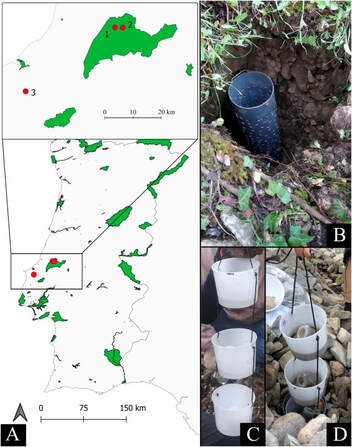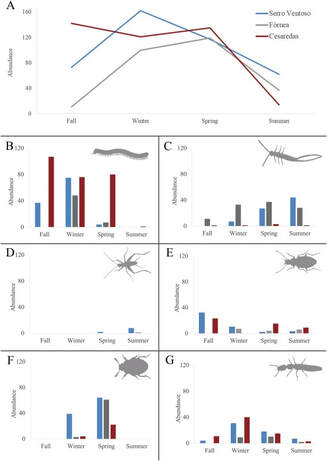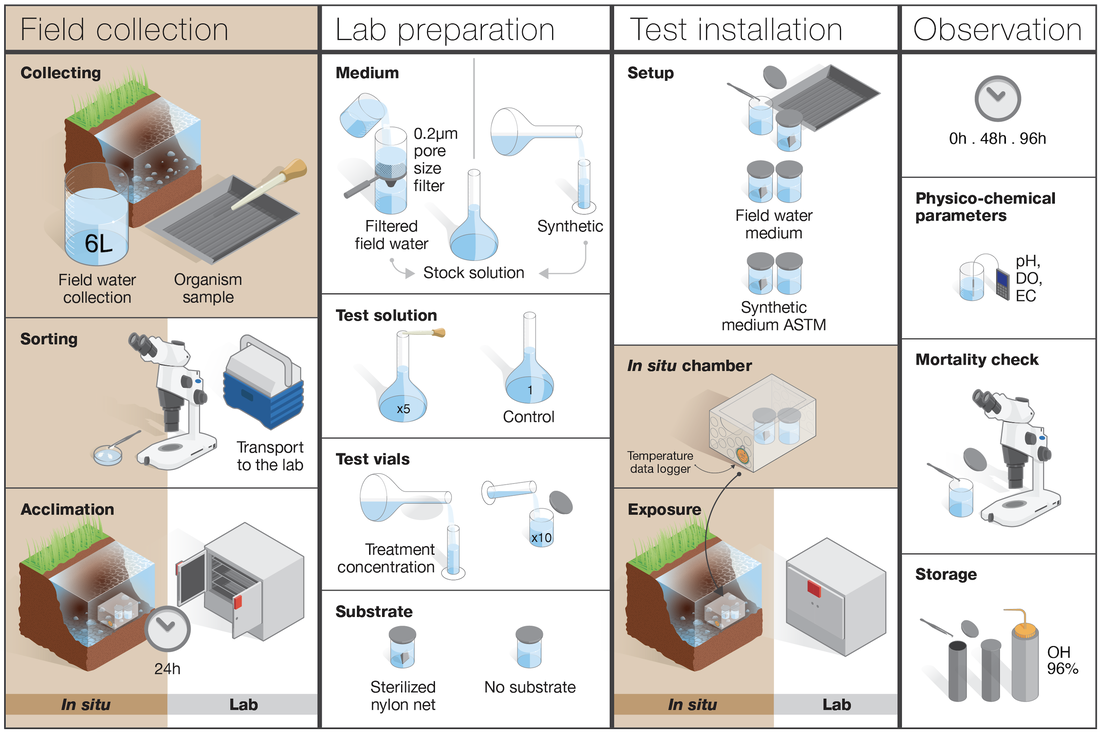The mesovoid shallow substratum (MSS) can act as a climatic refuge for invertebrates, as a biogeographic corridor to deeper substrates or as a permanent habitat for some species. This study characterizes the seasonal invertebrate diversity and abundance of MSS ecosystems in central Portugal focusing on Diplopoda, Diplura, Orthoptera and Coleoptera during one year. Sampling was performed with standard MSS pitfalls in scree slopes (colluvial MSS) of karst areas and environmental parameters (temperature, pH, conductivity, water content, organic carbon, nitrate, phosphate and ammonium) were quantified. Our results show that winter was the season with the highest arthropod abundance and that the MSS acts as a permanent habitat for chordeumatidan millipedes and as a climatic refuge for orthopterans and most beetles. All Diplura collected belong to a single species known previously from surface habitats in the Iberian Peninsula, which does not seem to use the Portuguese MSS as a refuge. MSS habitats in central Portugal, classified as western Mediterranean and thermophile deposits protected by the Natura 2000 network based on plant communities and geology, revealed an abundant and diverse invertebrate community that urges characterization and protection.
|
ABSTRACT The mesovoid shallow substratum (MSS) can act as a climatic refuge for invertebrates, as a biogeographic corridor to deeper substrates or as a permanent habitat for some species. This study characterizes the seasonal invertebrate diversity and abundance of MSS ecosystems in central Portugal focusing on Diplopoda, Diplura, Orthoptera and Coleoptera during one year. Sampling was performed with standard MSS pitfalls in scree slopes (colluvial MSS) of karst areas and environmental parameters (temperature, pH, conductivity, water content, organic carbon, nitrate, phosphate and ammonium) were quantified. Our results show that winter was the season with the highest arthropod abundance and that the MSS acts as a permanent habitat for chordeumatidan millipedes and as a climatic refuge for orthopterans and most beetles. All Diplura collected belong to a single species known previously from surface habitats in the Iberian Peninsula, which does not seem to use the Portuguese MSS as a refuge. MSS habitats in central Portugal, classified as western Mediterranean and thermophile deposits protected by the Natura 2000 network based on plant communities and geology, revealed an abundant and diverse invertebrate community that urges characterization and protection. Reference: Eusébio R., Enghoff H., Solodovnikov A., Michelsen A., Barranco P., Salgado J.M., Sendra A. & Reboleira A.S.P.S. (2021). Temporal and spatial dynamics of arthropod groups in terrestrial subsurface habitats in central Portugal. Zoology. https://doi.org/10.1016/j.zool.2021.125931
On Wednesday, April 28, at 8:30pm (GMT+1), join us for the webinar "The Classical (Caves and) Karst", by Dr. Matej Blatnik, Researcher at the Karst Research Institute ZRC SAZU in Postojna (Slovenia).
The “Classical Karst” comprises the area between Ljubljana (Slovenia), Trieste (Italy) and Rijeka (Croatia), and it is the area with the oldest scientific exploration of karst. The first mentions to this geographical areas dates back to ancient times, whereas the scientific explanation of processes in karst areas began in the 17th century. The word “Karst” (originally kras), as well as the early descriptions of widespread karst phenomena, e.g. dolina, uvala, polje or ponor, originated from Slavic words and are result of early explorations in the Classical Karst. The first institute completely dedicated to karst exploration was established more than century ago in Postojna (Slovenia), with the main goal of developing the multidisciplinary study and protection of karst areas. Our travel across the Classic Karst will focus mostly on karstology, providing a geographical overview its caves and karst, historical perspective and current research trends, with amazing images from this iconic karst area. “The Cave Show” is a series of (online) seminars about why are caves important, why it is important to study and protect caves, but also about our passion for caves, which drive much of our research activities. It is included in the celebrations of the International Year of Caves and Karst (http://iyck2021.org). More info: https://ce3c.ciencias.ulisboa.pt/outreach/press&events/ver.php?id=1308 Overview of the experimental design. ABSTRACT
Current standardized laboratory test protocols use model species that have limitations to accurately assess native species responses to stressors. We developed and tested a novel acute in situ protocol for testing field-collected organisms. We used Asellus aquaticus and NaCl as a reference toxicant to test for the effects of location (laboratory vs. in situ), medium (synthetic vs. field water), substrate (presence vs. absence), and protocol replicability. We further tested the protocol using groundwater-adapted isopods: Proasellus assaforensis for the effect of location, P. cavaticus of medium and P. lusitanicus of substrate. Our results showed that A. aquaticus lethality obtained with the novel acute in situ protocol did not significantly differ from those from laboratory testing. However, laboratory tested P. assaforensis showed a higher sensitivity, suggesting that its acclimation to laboratory conditions might have pernicious effects. A. aquaticus and P. cavaticus showed a higher mortality using synthetic medium insitu and under laboratory conditions, which overestimated the stressor’s effect. Besides, substrate use had no significant effect. The novel acute insitu protocol allows the use of native species under realistic scenarios. It is particularly well adapted for assessing the risk of groundwater ecosystems but it can be applied to a wide range of ecosystems. Reference: Castaño-Sánchez A., Malard F., Kalčikova G. & Reboleira A.S.P.S. (2021). Novel Protocol for Acute In Situ Ecotoxicity Test Using Native Crustaceans Applied to Groundwater Ecosystems. Water, 13(8): 1132. https://doi.org/10.3390/w13081132 |
Dimidium facti qui coepit habet: sapere aude
Archives
January 2024
Categories
All
|



 RSS Feed
RSS Feed
